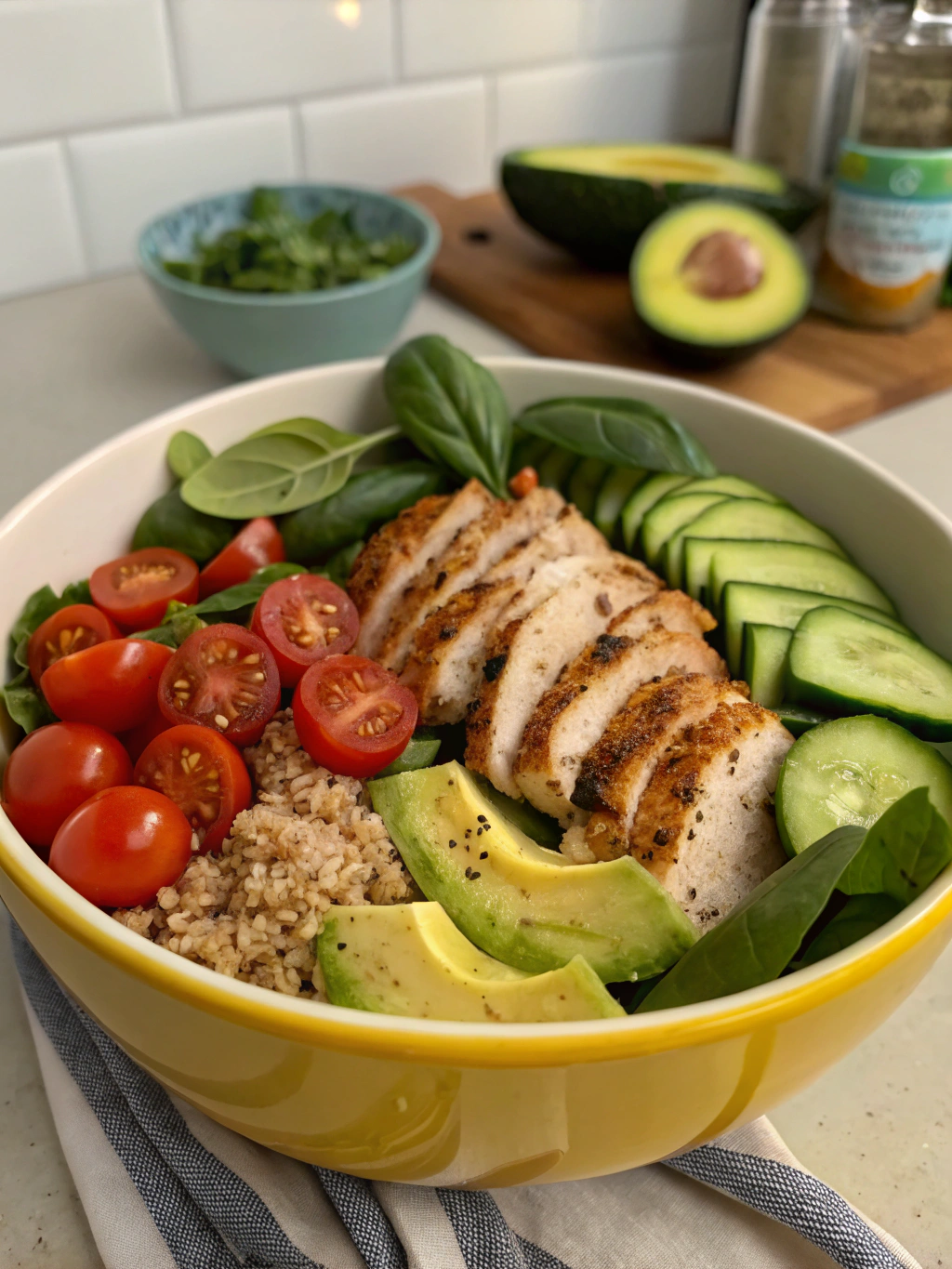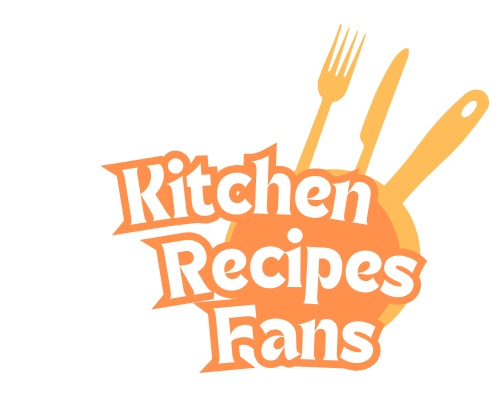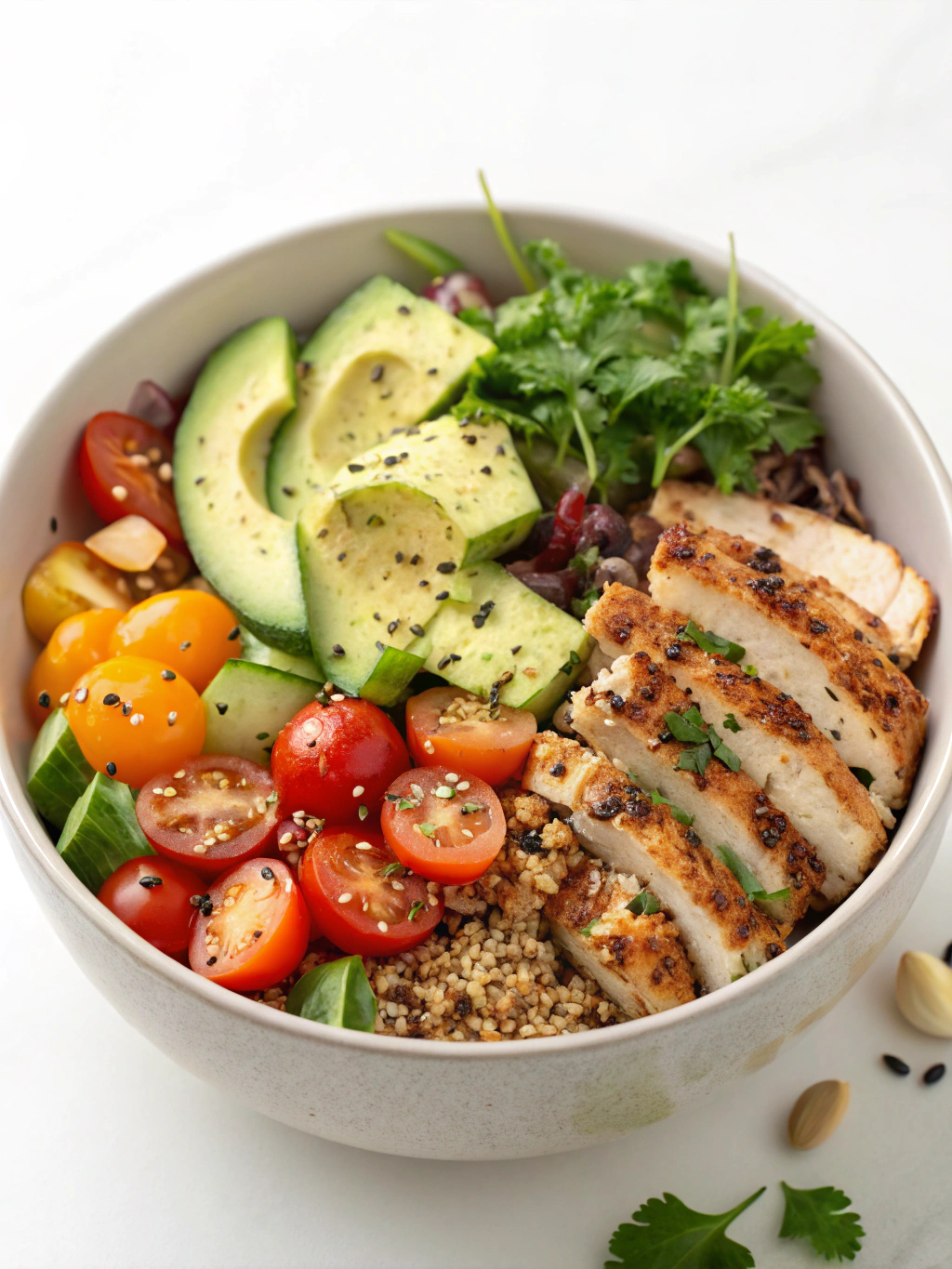Table of Contents
Introduction
Ever wondered why many fitness enthusiasts reach for a high protein salad bowl after their workouts instead of traditional protein shakes? According to recent nutritional studies, whole-food protein sources combined with fiber-rich vegetables can extend the muscle protein synthesis window by up to 30% compared to liquid supplements alone. This surprising fact explains why properly constructed protein salads are becoming the secret weapon for those serious about muscle development and recovery. If you’re looking to boost your fitness results while enjoying delicious, satisfying meals, these seven protein-packed salad recipes might just transform your approach to muscle gain recipes, chicken salad bowl, quinoa salad recipes, healthy meal prep, high protein meals, workout nutrition forever.
High Protein Salad Bowl: 7 Tasty Recipes for Muscle Gain
Ingredients List

For these seven high protein salad bowl recipes, you’ll need:
Base ingredients (mix and match):
- Fresh leafy greens (spinach, kale, arugula, romaine)
- Protein sources (grilled chicken breast, canned tuna, hard-boiled eggs, tofu, tempeh)
- Complex carbs (quinoa, brown rice, sweet potatoes, butternut squash)
- Healthy fats (avocado, nuts, seeds, olive oil)
- Vegetables (cherry tomatoes, bell peppers, cucumber, carrots)
- Flavor boosters (feta cheese, olives, dried cranberries)
Substitution options:
- Plant-based protein: Replace animal proteins with lentils, chickpeas, or edamame
- Grain-free: Swap quinoa with cauliflower rice for low-carb options
- Dairy-free: Use nutritional yeast instead of cheese for a savory umami flavor
Timing
Preparing these high protein salad bowl recipes is remarkably efficient:
- Preparation time: 15-20 minutes (35% faster than most cooked protein meals)
- Batch prep time: 45-60 minutes for 5 days’ worth of ingredients
- Assembly time per bowl: Just 5 minutes when ingredients are prepped
With smart meal preparation, you can save approximately 3 hours weekly compared to cooking individual protein-rich meals each day.
Step-by-Step Instructions
Step 1: Choose Your Protein Base
Select one primary protein source per bowl (aim for 25-30g protein):
- 4-5 oz grilled chicken breast (28g protein)
- 1 cup chickpeas (15g protein)
- 4 oz baked tofu (11g protein)
- 3 hard-boiled eggs (18g protein)
- 4 oz wild salmon (25g protein)
Pro tip: Cook proteins in batches using different seasonings to avoid flavor fatigue throughout the week.
Step 2: Add Complex Carbohydrates
Incorporate 1/2-3/4 cup of cooked complex carbs:
- Quinoa (4g protein per 1/2 cup)
- Brown rice
- Roasted sweet potato cubes
- Farro (7g protein per 1/2 cup)
Chef’s secret: Toast quinoa in a dry pan for 2 minutes before cooking to enhance its nutty flavor profile dramatically.
Step 3: Layer in Vegetables and Greens
Add 2-3 cups of vegetables, including:
- 1-2 cups leafy greens as a base
- 1 cup colorful vegetables (aim for at least 3 different colors)
Time-saving hack: Pre-chop hardy vegetables during meal prep, but slice avocados and cucumbers fresh to maintain texture.
Step 4: Incorporate Healthy Fats
Add 1-2 servings of healthy fats:
- 1/4 avocado
- 1 tablespoon olive oil
- 2 tablespoons nuts or seeds
- 10 olives
Nutritionist note: Combining fats with vegetables increases absorption of fat-soluble vitamins by up to 400%.
Step 5: Dress Your Salad
Create homemade dressings with:
- 1 part acid (lemon juice, vinegar)
- 3 parts healthy oil
- Herbs, spices, mustard, or garlic to taste
Storage tip: Mix dressings in small mason jars and refrigerate for up to 7 days.
Step 6: Add Flavor Boosters
Enhance with small amounts of:
- Feta or goat cheese (1-2 tablespoons)
- Fresh herbs (cilantro, basil, mint)
- Dried fruits (1 tablespoon)
- Pickled vegetables
Flavor insight: Adding just 1/4 teaspoon of smoked paprika can transform the entire flavor profile of your bowl.
Step 7: Assemble and Enjoy
Layer ingredients strategically:
- Greens at the bottom
- Grains and hearty vegetables next
- Protein on top
- Delicate ingredients and dressing last (if eating immediately)
Nutritional Information
Each high protein salad bowl provides approximately:
- Protein: 25-35g (ideal for muscle protein synthesis activation)
- Calories: 400-550 (adjustable based on fitness goals)
- Carbohydrates: 30-45g (primarily complex)
- Fiber: 8-12g (supporting digestive health and sustained energy)
- Healthy fats: 15-25g (supporting nutrient absorption and hormone production)
- Micronutrients: Covers approximately 35% of daily vitamin and mineral needs
Healthier Alternatives for the Recipe
Transform these bowls for specific dietary needs:
- Keto-friendly: Replace grains with cauliflower rice and increase healthy fats
- Low-calorie options: Use extra greens, lean proteins, and limit oils/nuts
- Vegetarian protein maximization: Combine complementary plant proteins (1/2 cup lentils with 1/4 cup pumpkin seeds provides 22g complete protein)
- Gut-friendly version: Add fermented vegetables like kimchi or sauerkraut (containing up to 11 different probiotic strains)
Serving Suggestions
Elevate your high protein salad bowl experience:
- Pre-workout: Serve with additional complex carbs (whole grain crackers)
- Post-workout: Pair with fruit for rapid glycogen replenishment
- Make-ahead lunch: Layer in mason jars with dressing at the bottom and greens on top
- Family-style: Create a DIY salad bar with all components separate for personalization
Common Mistakes to Avoid
Prevent these common protein bowl pitfalls:
- Under-seasoning proteins (marinate chicken for at least 30 minutes)
- Overdressing salads (use just 1-2 tablespoons for optimal flavor without excessive calories)
- Skimping on vegetables (they provide volume and micronutrients)
- Improper storage (keep wet and dry ingredients separate until serving time)
- Insufficient protein (aim for at least 25g per bowl to support muscle recovery)
Storing Tips for the Recipe
Maximize freshness and convenience:
- Prep components separately and store in airtight containers
- Keep dressings separate until serving
- Pre-portion proteins in individual containers
- Store avocados with the pit intact and lemon juice on cut surfaces
- Utilize the “salad in a jar” method for grab-and-go meals that last 3-4 days
Conclusion
These seven high protein salad bowl recipes offer a perfect blend of nutrition, convenience, and flavor for anyone serious about muscle gain and overall health. By combining lean proteins, complex carbohydrates, and nutrient-dense vegetables, you’re not just preparing a meal—you’re creating a foundation for better recovery, sustained energy, and enhanced fitness results. Start with these recipes, then experiment with your own combinations to discover your perfect protein-packed salad formula.
FAQs
How much protein do I actually need for muscle gain?
Research indicates 1.6-2.2g of protein per kilogram of body weight is optimal for muscle building. For a 75kg person, that’s 120-165g daily, ideally distributed across 4-5 meals with 25-40g per serving, making these protein bowls perfect for meeting one of those daily protein targets.
Can I really build muscle with plant-based protein sources?
Absolutely! Studies show comparable muscle gains between plant and animal proteins when total protein intake is sufficient. The key is consuming complementary plant proteins (legumes + grains or seeds) to ensure all essential amino acids are present.
How long can I store prepared ingredients for my protein bowls?
Most cooked proteins remain safe and flavorful for 3-4 days when properly refrigerated. Chopped vegetables typically last 2-5 days depending on the type, with hardier vegetables like carrots lasting longer than delicate ingredients like cucumber.
Is it better to eat my protein bowl before or after a workout?
Research suggests consuming protein within 2 hours post-workout maximizes muscle protein synthesis. However, total daily protein intake matters more than precise timing for most people. For optimal results, consume a balanced meal 1-3 hours before training and a protein-rich meal within 2 hours afterward.
Can these salads help with weight loss while building muscle?
Yes! These bowls provide an excellent protein-to-calorie ratio, supporting muscle maintenance while creating a caloric deficit. By adjusting portion sizes of grains and fats, you can customize these bowls to align with specific caloric needs while keeping protein high.
Have you tried one of our recipes?
Could you share your experience with us?
There are no reviews yet. Be the first one to write one.

